Cuplock scaffolding is a widely used scaffolding system in the Middle East. This modular scaffolding system is employed in construction, industrial, commercial, and structural applications. Commonly, galvanized or multipurpose steel is used to create readymade scaffolding components. The galvanized finish of steel ensures durability and resistance to wear/damage. Cuplock scaffolding components are manufactured under stringent quality standards. ISO-certified manufacturers test raw materials and welding lines according to international standards to ensure that every system or component is high quality.
The main benefits of cuplock scaffolding are easy assembly, durability, versatility, low maintenance, and accessibility. The main components of cuplock scaffolding are standard ledgers, intermediate transoms, and cantilever beams. Main cuplock scaffolding accessories include standard cuplock, ledgers, bevels, brackets, adjustable leveling jacks (and U heads), cuplock steel plates, and base plates. The main uses of cuplock scaffolding are in building construction, form support structures, load-bearing platforms, event staging, access towers, and infrastructure projects.
Table of Contents
What is Cuplock Scaffolding?
Cuplock scaffolding is a modular scaffolding system with a unique locking mechanism. Its design includes a unique circular cup-node point that connects up to four scaffolding horizontal components such as ledgers, transoms, or braces with a vertical component or access standards in a single installation. The absence of loose components and the galvanized finish contribute to its robust, durable performance. The locking mechanism has a node point locking device consisting of a fixed bottom cup (welded at 0.5 m intervals) and a sliding top cup that drops over the blade ends.
Fixed bottom cups are the primary connecting points for ledgers and braces. The sliding top cup is placed over the fixed bottom cup. This sliding top cup is slid down to lock the blade of horizontal components on the bottom cup. This unique locking mechanism locks components securely with a single hammer stroke. Cuplock scaffolding design eliminates the need for loose clips, screws, or wedges, so it enables fast and simple assembly. When the structure is upright and level, the subsequent lift aligns automatically.
What Are The Benefits of Cuplock Scaffolding?
The seven benefits of cuplock scaffolding are as follows:
- Quick Assembly
- Versatility
- Durability
- Low maintenance
- Accessibility
- Safety
- Cost-effective
1. Quick Assembly
The biggest benefit of cuplock scaffolding is quick and easy assembly, all thanks to its unique node point locking mechanism that locks cuplock standards and vertical in place. It doesn’t involve loose components, so there is no need to use nuts or bolts. Fewer components are required to create a cuplock scaffolding frame. Workers can lock and unlock scaffolding compliments with a hammer strike. Quick assembly and dismantling allow you to complete your construction task with speed
2. Versatility
Another plus point of cup lock scaffolding is its versatility. It blends well with various construction sites. Whether you are going to work on a complex structure or facade, the modular design makes configuring multiple sizes and shapes hassle-free.
3. Durability
Cuplock components are made of high-strength steel to ensure that they are highly durable and can withstand harsh weather conditions. When you need a scaffolding system for heavy-duty applications, Cuplock offers great resilience as it can withstand harsh environments.
4. Low Maintenance
The cuplock system is low maintenance due to its simple design and high-quality materials. The galvanized steel cuplock system provides high strength and great resistance to rust and corrosion, thus increasing overall lifespan with less frequent maintenance or replacement requirements.
5. Accessibility
Cuplock scaffolding systems usually have an integrated staircase, allowing workers to climb the scaffold effortlessly and access different levels of the building with ease.
6. Safety
Cuplock scaffolding is safe to use thanks to its secure locking mechanism, which ensures that components remain secure in the plate and don’t dislocate. This system is also integrated with safety features such as access ladders, toeboards, and guardrails to ensure workers have a stable and safe surface for use.
7. Cost-Effective
The quick assembly features of cup lock scaffolds make them a cost-effective option. They reduce labour costs on-site while saving time. Cuplock scaffold components are durable, so investing in them will offer long-term benefits.
What are the Uses of Cuplock Scaffolding?
The eight uses of cuplock scaffolding are as follows:
- Building and construction sites
- Support structures
- Load-bearing platforms
- Renovations and refurbishments
- Event staging and temporary structures
- Access and stair towers
- Infrastructure projects
- Overhead and ceiling works
1. Building and Construction Sites
Cuplock scaffolding is commonly used on construction sites for residential, commercial, and industrial projects. From bricklaying to painting and plastering, this scaffolding system allows construction workers to handle a variety of tasks with ease and speed.
2. Support Structures
Cuplock scaffolding provides a support structure for formwork during concrete construction. It includes shoring, which supports structure weight while you are working on repair or alteration projects. When you have a new build project, it provides formwork support, especially when concrete needs to be poured and cured for complex structures.
3. Load-Bearing Platforms
Cuplock scaffolding provides an excellent load-bearing platform during bridge construction and industrial maintenance projects. It supports the significant weight of heavy material and equipment that must be used at height.
4. Renovation and Refurbishment Projects
Steel cup lock scaffolding is commonly used for renovation and refurbishment projects. It’s a flexible structure that can be configured around existing structures without causing damage or permanent changes to them. It offers safe access to difficult-to-reach areas during renovation projects.
5. Event Staging and Temporary Structures
Cuplock scaffolding offers quick and simple assembly, making it ideal for event staging, lighting rigs, and seating standards. Scaffolding components can be customized to event requirements.
6. Access and Stair Towers
Cuplock scaffolding serves as access and stair towers at the construction site. It allows workers easy and safe access to different building levels. Contractors can use cuplock scaffolding to build towers at significant heights without compromising system stability, offering workers safe vertical movement.
7.Infrastructure Projects
Industrial-grade steel cup lock scaffolding is used for large infrastructure projects. It provides the required support to workers and materials over and under highways, tunnels, and bridges. Its high load-bearing capacity and ability to cover large distances make it the most suitable scaffolding type for infrastructure projects.
8. Overhead and Ceiling Work
Cuplock scaffolding is configured as birdcage scaffolding for ceiling and overhead work. When contractors install mechanical, electrical, and plumbing systems, Cuplock offers them a platform that surrounds the work area. This birdcage scaffolding made from Cuplock components lets workers move tools and materials freely and safely.
What Are Materials Used in Cuplock Scaffolding?
Four raw materials used in cuplock scaffolding are as follows:
- Aluminum
- Galvanized or High-Grade Steel
- S355 steel grade
- Engineered Plastics
1. Aluminum
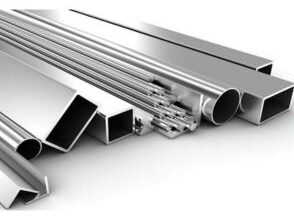
Aluminum is a lightweight and corrosion-resistant material used to make light-duty cup lock scaffolding for temporary stages or exhibition stands. This material is strong yet has a lower load-bearing capacity than galvanized steel. Aluminium only creates clock parts when a project requires quick assembly and portability.
2.Galvanized or High-Grade Steel

Galvanized or high-grade steel is commonly used for cup lock scaffolding, offering great strength and resilience. It is stronger than aluminium and provides excellent load-bearing capacity. Galvanized steel has a protective layer of zinc to prevent rust and corrosion and make ready-made cuplock scaffolding components durable.
3.S355 Steel Grade

The S35 Steel grade is a European standard high-strength, low-alloy structural steel known for its high tensile strength and yield. When a cuplock scaffolding system is needed for industrial projects where a high strength-to-weight ratio is required, the S355 steel grade is used to make clock components.
4.Engineered Plastics

Engineered plastics are used to manufacture non-load-bearing components of cup lock scaffolding, such as base plate covers, protective caps, and other fittings. Plastics are known for their strength, anti-corrosion properties, and flexibility. Parts made with engineered plastic withstand harsh weather conditions.
What are the components of a Cuplock scaffolding system?
Four components of a cuplock scaffolding system are as follows:
- Cuplock Standards
- Ledgers
- Intermediate Transoms
- Cantilever frames
1.Cuplock Standards

Cuplock standards are prefabricated vertical components positioned with a lower cup at 0.5m intervals and fixed with a rotatable top cup, which can securely hold up to four components. To improve the structural strength of the cup lock system, the narrowest bottom cup is placed 80mm from the standard base. Access standards include a 150 mm spigot at the top for vertical connection and a lock pin.
2.Ledgers
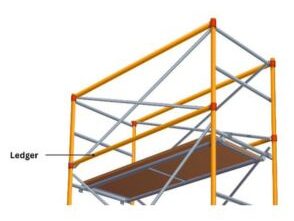
Cuplock ledgers support the overall system horizontally. They are secured with vertical tubes to ensure a solid framework assembly. Horizontal scales are integrated into the bottom cup. The 2.5m bay is suitable for common access load combinations, where 1.8m cuplock horizontals provide additional flexibility. In the staircase tower, horizontals also serve as guardrails.
3.Intermediate Transoms

Intermediate transoms provide mid-bay support to 38mm scaffold boards between internal and external ledgers. They are connected with inner and outer horizontal ledgers to lock these cuplock scaffolding components in their place. Each end of intermediate transoms has a folded jaw-like design to ensure that ledgers don’t dislocate from the overall framework. One end is equipped with an integrated locking device to secure positioning. The standard unit width is 1.3 m; smaller slings are available for varying panel support needs (designed for 2‑board and 3‑board hop‑up brackets). The 1.4m transoms with a 5-panel platform also serve the purpose of handrails. They can also create corner returns without overlapping.
4.Cantilever Frames
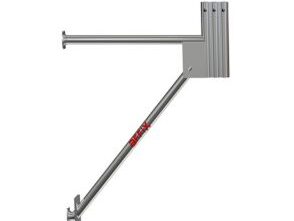
Cantilever frames extend the reach of the scaffolding system beyond its normal base structure. When you need to access hard-to-reach areas, these frames provide a platform, especially when vertical supports can not be set underneath the working area. These frames are anchored securely to a stable scaffold section and extend outward to support a platform.
What Are Parts of Cuplock Scaffolding?
Five parts of cuplock scaffolding are as follows:
- Base Plates
- Decking Beams and Infill Beams
- Drop Heads
- Round Spigots and Spigot Bolt Nuts
- Unit Beams
1.Base Plates

Base plates are a foundational part of the cup lock scaffolding system. They are used in conjunction with the Universal Jack to distribute the load of the scaffold evenly across the ground and maintain the stability of the cup lock scaffolding structure. Base plates are square steel plates with a central shank secured to the cuplock scaffold standards. The spigot is pre-drilled to allow the insertion of a tight bolt if necessary. Headplates and base plates prevent the structure from sinking into the ground and ensure its upright position remains intact.
2.Decking Beams and Infill Beams
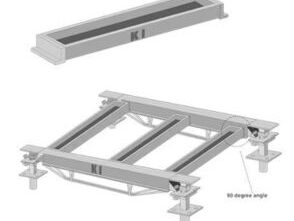
Decking beams are horizontal clock parts secured across the scaffolding bays to support the deck or platform. Infill beams are used to fill the gaps in the scaffolding where cuplock standards do not fit around complex structure geometries. They ensure that workers have a safe and continuous platform by covering all the openings of the scaffolding deck to prevent workplace hazards.
3.Drop Heads
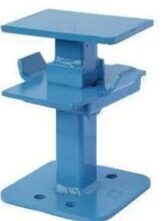
Drop heads featuring decking systems remove decking beams without impacting the vertical load-bearing elements of the cuplock. These beams make the dismantling process quick and simple.
4.Round Spigots and Spigot Bolt Nuts

Round spigots are cylindrical connectors used in cuplock scaffolding to extend the vertical reach of the structure through the end-to-end connection of two standards. A spigot fits into a hollow scaffolding tube at the top of a standard to offer a secure connection point for the second standard. Spigot bolt nuts fasten cuplock components that fit the round spigot to the standards. However, they ensure the connection remains stable and prevent spigots from moving or dislodging under load.
5. Unit Beams

Unit beams are horizontal clock parts spanning larger distances than standard ledgers. They are used to support heavy loads while bridging the spacing left behind by cuplock standards. When a construction task requires large equipment movements, unit beams become integral parts of the cuplock scaffolding system as they create a large and clear area beneath the scaffold for easy work and access.
What are the accessories of Cuplock Scaffolding?
The eight accessories of cuplock scaffolding are as follows:
- Aluminium Beams (S-150 and T-150)
- LD Prop Jacks and Universal/Jacks
- Safety Handrails
- Steel Ladder Beams
- Steel Planks
- Steel Staircases
- Bevels
- Hop up brackets
1.Aluminium Beams (S-150 and T-150)

These are horizontal components of the Cuplock scaffolding system. Made from lightweight aluminium, these beams are easy to handle and provide exceptional durability and strength to a structure. S-150 and T-150 aluminium beams refer to load-bearing capacities. Aluminum S-150 is designed with a single web, while aluminium T-150 beams feature twin webs. The latter has a 40% increase in weight, so it offers more strength and stiffness than the S-150.
2.LD Prop Jacks and Universal Jacks
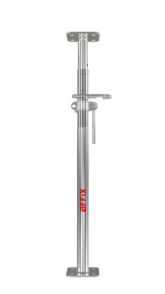
LD Prop jacks are adjustable vertical supports that maintain the structural integrity of the cuplock scaffold. They are used to support slabs and formworks. Universal jacks can be adjusted to different heights; their height adjustment range is approximately 0.5 m. Their load-bearing capacity is up to 74 kN. Universal jacks are designed for access and support structures to accommodate variations in ground and surface levels. They can be attached with standard nuts and bolts to the base, headboard, front, or adapter. They ensure that the cuplock scaffolding system remains stable on uneven ground.
3.Safety Handrails
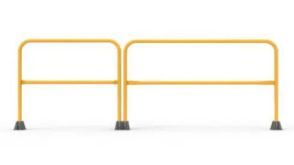
Safety handrails prevent accidental falls and maintain the safety of workers on scaffolds. These cup-lock scaffolding parts are installed along the edges of the scaffolding platform and work as barriers.
4.Steel Ladder Beams

Steel ladder beams are made from steel and span between scaffolding sections to offer support across wide gaps. They even help with the load distribution of the scaffolding by providing secure and stable connections.
5.Steel Planks
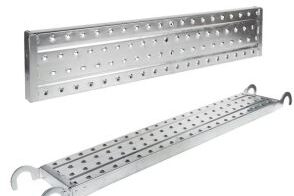
Steel planks are used to create the actual platform on which workers stand. These are typically made of galvanized steel to resist corrosion and can handle heavy loads, providing a solid and safe working area for construction activities.
6.Steel Staircases
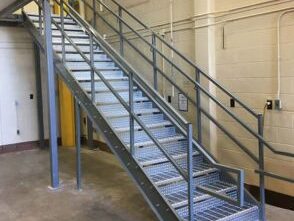
They are important cup lock scaffolding parts that allow workers safe and easy access to varied levels of structure. Steel staircases are designed for heavy traffic use and offer safe means of vertical movement for materials and workers.
7. Bevels

Bevels are angled components of the cuplock scaffolding system. They fit the scaffolding system with the contour of the structure and accommodate specific geometries. When scaffolding needs to interface with an existing structure whose shape is not perfectly horizontal or perpendicular, contractors use bevels to fit the scaffolding against a non-uniform surface. Properly aligning scaffolding components increases safety and reduces the risk of accidents.
8.Hop-up Brackets
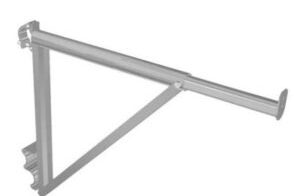
Hop-up brackets are specialized scaffolding components designed to expand the work platform width to 7 or 8 panels. These brackets support installing two or three additional panels outside the scaffold’s interior and let workers reach wide areas. The design of hop-up brackets incorporates a cup joint on the outer end to facilitate the installation of an internal ledger that connects the two brackets and supports the intermediate crossbar. They feature an additional support for the railing post. They are mainly used for platform extensions. When you must complete work at multiple heights, hop-up brackets can be adjusted to varied heights. Iso-certified cuplock manufacturers follow Stringent safety standards to build hop-up brackets to ensure that they hold workers and their tools securely and without causing any risk of collapse.
What is a Cuplock System?
Cuplock system is a type of steel scaffolding system where components of scaffold such as standards, ledgers and transoms are connected using a unique circular cup node-point. This central point allows you to connect up to 4 components in a single installation. The major parts of cuplock systems are braces, ledgers, standard cuplock, adjustable leveling jack base, and brackets. These lightweight and durable cuplock parts are manufactured by following the industry’s safety load requirements. This system is quite famous all over the UAE because of its quick and easy assembly.
This steel-made system has a protective layer of hot-dip galvanizing that ensures that the system can withstand harsh weather conditions. This coating increases its lifespan and makes it highly resistant to regular wear and tear. The Cuplock system has ready-made scaffolding components. You can also find this system with powder-coated and painted cuplock scaffolding materials. The whole system is manufactured by following stringent quality and industry safety standards. Cuplock system components are super adaptable and easy to integrate with traditional beams and panels. It’s easy for you to use the cuplock system to build versatile access and support structures such as mobile towers, loading towers, circular scaffolding, birdcage scaffolding and stair towers. Its prefabricated components allow you to create and formwork scaffolding of varied types and sizes. Whether you want to build scaffolding for industries or formwork scaffolding for construction or building, it’s pretty feasible with cuplock components.
What is the Cuplock Scaffolding System Size?
The standard sizes of the cuplock scaffolding system are 0.5 m, 1.0 m, 1.5 m, 2.0 m, 3.0 m, etc. You can find all the sizes of cuplock ledgers in the range of 0.6m to 3.0m. Customization options for vertical bay include 0.5 m, 1.0 m, 1.5 m, 2.0 m, 3.0 m, etc. Light duty parts of the cuplock scaffolding system are made from OD 48 x 3.2 mm scaffolding tubes (Type 3) while heavy duty components are manufactured using OD 48.3 x 4.0 mm scaffolding tubes (Type 4).
How to calculate the amount of Cuplock scaffolding?
The amount of cuplock scaffolding is calculated based on the overall area and structure to be scaffolded. A common approach is calculating the volume of cuplock scaffolding around the building and the volume of scaffolding shorts from concrete slabs and beams. The amount of cuplock scaffolding is calculated by trained scaffolding engineers or specialized scaffolding estimation software. To calculate the volume around the building, first, you measure the perimeter of the building. The purpose here is to determine the exact horizontal length of scaffolding required.
The next step is to calculate the scaffold height based on the several stories you need in a cuplock scaffolding and the specific height to reach the structure at varied height levels. Multiply the perimeter by the scaffold height to calculate the area that needs to be scaffolded. Based on the volume of cuplock scaffolding around the building, you will calculate the number of scaffolding components required to create a framework.
When erecting a scaffold on uneven and sloppy surfaces, you will calculate the amount of cuplock scaffolding based on the volume of scaffolding supports from concrete slabs and beams. It will consider underlying structure support and calculate the amount of cuplock scaffold based on load-bearing points. First, identify load points and calculate the number of base plates required. Next, you will identify the vertical and horizontal supports required to create a stable scaffold structure.
What’s The Cuplock Locking Procedure?
The cuplock locking procedure includes a unique node point locking device at the heart of the cuplock system. This device lets you attach up to four horizontal components to the standards loosely yet firmly. Once you attach horizontals with verticals, you lock them into their position with a single hammer stroke. You don’t need to rely on loose screws, wedges, or clips that are common in other scaffolding systems. The locking mechanism is simple: it has a fixed bottom cup welded at 0.5m intervals and a sliding top cup. The top cup tolerates the stabling of the structure by securing components horizontally. This unique node point eliminates the need for loose components and simplifies the assembly process.






